

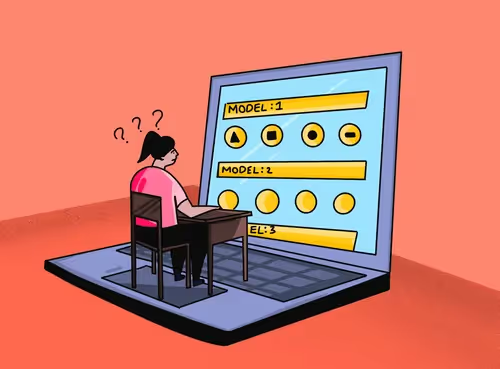
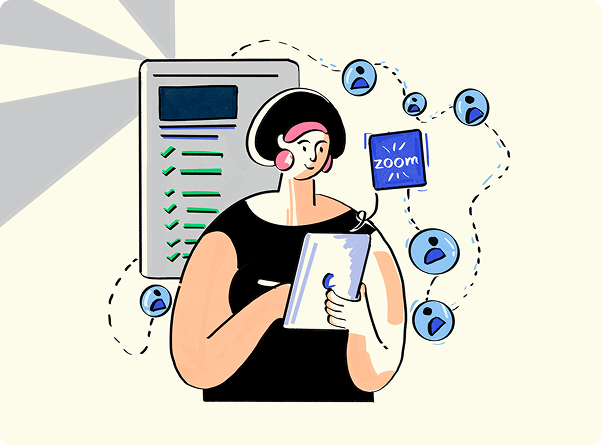

Key Takeaways
- Your performance on the first section affects how challenging the second section will be, and harder sections offer more points.
- Doing well in the first section is key, as weaker performance leads to an easier second section, which limits your scoring potential.
- The second section has more impact on your total score, so answering correctly in a harder second section is critical for achieving top marks.
The SAT has long played an important role in college applications. With its transition to a digital format, gaining clarity on the digital SAT scoring algorithm has become increasingly important.
This blog delves into the details of how the digital SAT is scored, featuring insights from Laura Whitmore, a seasoned SAT and ACT test prep tutor and owner of Strategic Test Prep.
Adaptive Digital SAT Scoring
The Digital SAT uses an adaptive scoring system that adjusts the difficulty of sections based on a student's performance. On this test, your results in the first section of either English (Reading and Writing) or Math determine whether the second section will be more challenging or less so. A more difficult second section allows for higher scoring potential, whereas an easier section sets a lower ceiling for the maximum score. This approach is designed to align the test's difficulty with the individual’s skill level.

- Section-Level Adaptivity: The test has two sections for each subject, where the difficulty of the second section is based on performance in the first.
- Performance Impact: Strong results in the first section lead to a harder second section with higher scoring opportunities, while weaker results result in an easier second section.
- Adaptive Algorithm: The test adjusts question difficulty dynamically, but the exact method is not disclosed by the test creators.
- Test Precision: This format aims to match the difficulty of the questions to the test-taker's skill level for accurate evaluation.
- Strategic Approach: Performing well in the first section and maintaining accuracy throughout the test are key to achieving high scores.
Digital SAT Scoring Algorithm
The Digital SAT scoring process employs an adaptive testing system that adjusts the difficulty of questions based on a student’s performance. The scoring breakdown is as follows:
- Raw Score: The total count of correct answers, with no penalties for incorrect ones.
- Scaled Score: Raw scores are converted to a scale of 200–800 for each section (Reading and Writing, Math) through statistical adjustments to maintain fairness.
- Composite Score: The scores from both sections are combined, resulting in a total score ranging from 400 to 1600.
- Subscores: Specific skill areas are assessed and reported on a scale of 1 to 15 for additional feedback.
This method ensures scoring accuracy, consistency, and equity for all test-takers.
📌 Note: The specific details of the algorithm are not publicly disclosed by the College Board, the organization that administers the SAT. However, it is designed to account for factors such as the difficulty level of the questions and the performance of other test takers.
How the English Digital SAT Scoring Algorithm Works
The English Digital SAT scoring algorithm assesses test takers' performance in the English sections, considering factors such as correct answers, question difficulty, and adaptive adjustments based on prior performance.
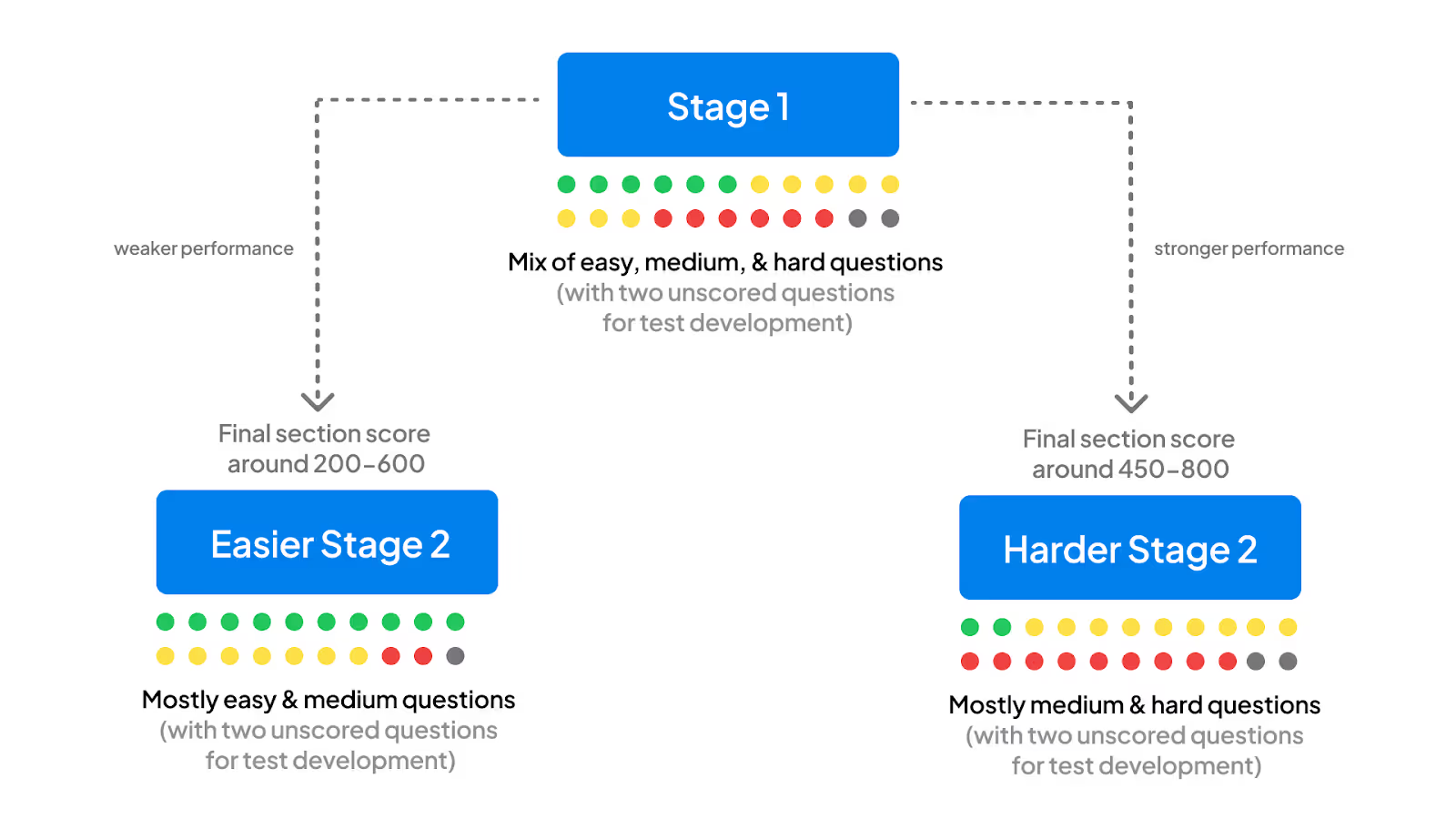
Things to remember
- The English section contains 54 questions in total (27 questions in each section and 32 minutes per section). Two sections to attempt. Attempting the first section will decide the difficulty of the second section.
- If one does well in the first English section, they get the harder second section.
- If one doesn't do well in the first English section, they get the easier second section.
Now let’s look at the possible scenarios that will help one achieve their desired score.
How many can one get wrong on the 1st set and still get the second set of harder questions?
If one gets 10 questions wrong, they will still get the second harder section. The 1st section has 27 questions so if you miss 10 you’ll get the second harder section.
If one gets an easier 2nd set, i.e. if one gets more than 10 questions wrong in the first part, what is the highest score one can get, even if they score well in the second part?
This trial was conducted by missing 12 questions to get a more comprehensive understanding of the digital SAT scoring algorithm.
So, if one misses a little bit more than 10 questions, i.e. 12 questions, in the first set then they will get the second easier set. Even if they score all the questions right in the second set, their total score comes to 560. This means that if they score poorly in the first set even after acing the second set, there is still no chance of scoring more than 600 and above in the reading and writing section.
After reversing the trial by getting all the questions right in the first section and missing 10 questions in the second section, the maximum total score is a 660.
What happens if one misses just 1 question in total/ gets only 1 question wrong?
After running a trial test where all the questions were right in the first set but 1 question was missed in the harder set, the total score was 770. Out of the 54 questions, getting only one question wrong in the harder set will cost a test taker 30 points. If we reverse the trial by missing one question in the first section and getting all the questions right in the second harder section one will end up scoring a perfect score of 800.
This gap identified needs to be kept in mind. Through trials and analysis it can be concluded that the second part weighs more than the first part, especially if the second part is a harder set of questions.
So to get a perfect score in the English section of the digital SAT, you have to get a perfect score in the second harder section.
Does missing a different question in the same set affect one’s score?
The score doesn’t get affected by missing a different question in the same set. Two trials were conducted for the same practice set. In each trial, different questions were missed in the first section and the score was the same and did not vary from the other. The same trials were conducted for the second section as well, where different questions were missed in the second
section and the score (770) remained the same for both trials.
What we can conclude from the trials is that it doesn’t matter which question one misses in each set/ section but the amount of questions one misses in each section/ set.
What if you guess the same letter the whole way through?
During a trial, all the answers were marked/guessed with the option ‘D.’ By doing so, the overall score came to 200. Getting a 200 is the lowest score for the SAT, so guessing will not help, as there’s no way one can score more than 200 in the digital format, unlike the pen and paper format.
How the Math Digital SAT Scoring Algorithm Works
The Math Digital SAT scoring algorit
hm assesses test takers' performance in the Math sections, considering factors such as correct answers, question difficulty, and adaptive adjustments based on prior performance.

Things to remember
- The Math section contains 44 questions in total (22 questions in each section and 35 minutes per section). Two sections to attempt. Attempting the first section will decide the difficulty of the second section.
- Digital SAT now comprises 15% geometry questions, with emphasis on triangles, circles and trigonometry.
- Word problems on calculating margin of error and interpreting equations are areas to look out for.
- Emphasis on more complex quadratics where ‘a>1’ is to be expected. The usage of the graphing calculator is of high importance in such questions.
- If one does well in the first Math section they get the harder second section.
- If one doesn't do well in the first Math section they get the easier second section.
Now let’s look at the possible scenarios that will help one achieve their desired score.
How does the digital SAT scoring algorithm for Math work?
One would want the harder second section as it is worth more points than the easier second section in the digital SAT scoring.
How many questions can you get wrong in the first Math section and still get the harder second section?
Out of the 22 questions in the first section, one can miss 10 questions to still get the harder second section. After receiving the harder second section and getting all the questions right, the maximum score one can get is 680. Remember, one needs to get at least 12 right in the first section to score 680.
What’s the highest score you can get if you get the easier second section?
Get 11 wrong in the first section and one will end up with the easier second section for Math. After attempting all the second section questions right the maximum score one can get is 560. That drops the Math section score by 120 points from the previous scenario.
How many questions can one miss to still be in the 700’s?
While trying out the practice test 4-5 questions were missed overall. 1 question from the first section and 3 questions from the second section. The total score obtained in the Math section was 720.
How much can one score if one misses only 2 questions?
In the first section, 2 questions were missed while in the second section all questions were attempted with the right answer and the overall score was 790.
How much can one score if one misses only 1 question, but in the first section?
In the first section, 1 question was missed while in the second section all questions were attempted with the right answer and the overall score was 800, a perfect score.
How much can one score if one misses only 1 question, but in the second harder section?
In the second harder section, 1 question was missed while in the first section all questions were attempted with the right answer and the overall score was 800, a perfect score.
How many questions can you get wrong on a digital SAT for 1500?
Scoring a 1500 places you in the top tier of test-takers. To achieve this, you’ll need around 750 in both Math and RW. The digital SAT adjusts its difficulty based on test takers performance, but typically:
- Missing 0 - 1 questions per section is SAFE..!!
- Missing more than 2 questions total could bring your score under 1500, depending on the curve.
Accuracy is key, but a minor slip in one section might still keep you in the range.
How many questions can I get wrong to get a 1300 on the digital SAT?
A 1300 is a strong score that reflects solid performance across the board. With a target of 650 in Math and RW, here’s what to expect:
- Math: Missing 5–8 questions often keeps your score near 650.
- RW: Missing 8–12 questions across Reading and Writing combined is typically fine.
Focus on getting as many correct as possible in the areas where you feel most comfortable, and you’ll be in good shape.
Preparation for the Digital SAT
Are you searching for a platform to help coach your students and prepare them for the Digital SAT test environment?
EdisonOS offers a dedicated digital SAT practice test platform crafted specifically for test prep tutors to streamline SAT preparation. It mirrors the official Bluebook practice tests and utilizes AI technology to provide an adaptive experience. The platform creates practice questions and delivers detailed feedback customized for each student's performance.
How can EdisonOS help tutors prepare students better for the Digital SAT?
We know that the digital SAT follows a module adaptive format where a student's performance in the first module influences the difficulty level of the next. So, more than just the content knowledge, the student must be aware of how the test adapts in real-time.
Here's how EdisonOS's digital SAT platform help you prepare students better:
1. Realistic test simulation
EdisonOS mirrors the official Bluebook interface used for practicing the Digital SAT exam. So, tutors can guide their students to take mock tests in the platform to reduce exam-day surprises and build familiarity with the real test environment.
2. Has its own scaled score system
EdisonOS lets tutors use and customize their own scaled score system. Tutors can configure their scale score using the template provided on the platform.
This system is designed to assign weighted values to each question based on its difficulty level and allows a weighted mean approach to scoring.
Let's take an example:
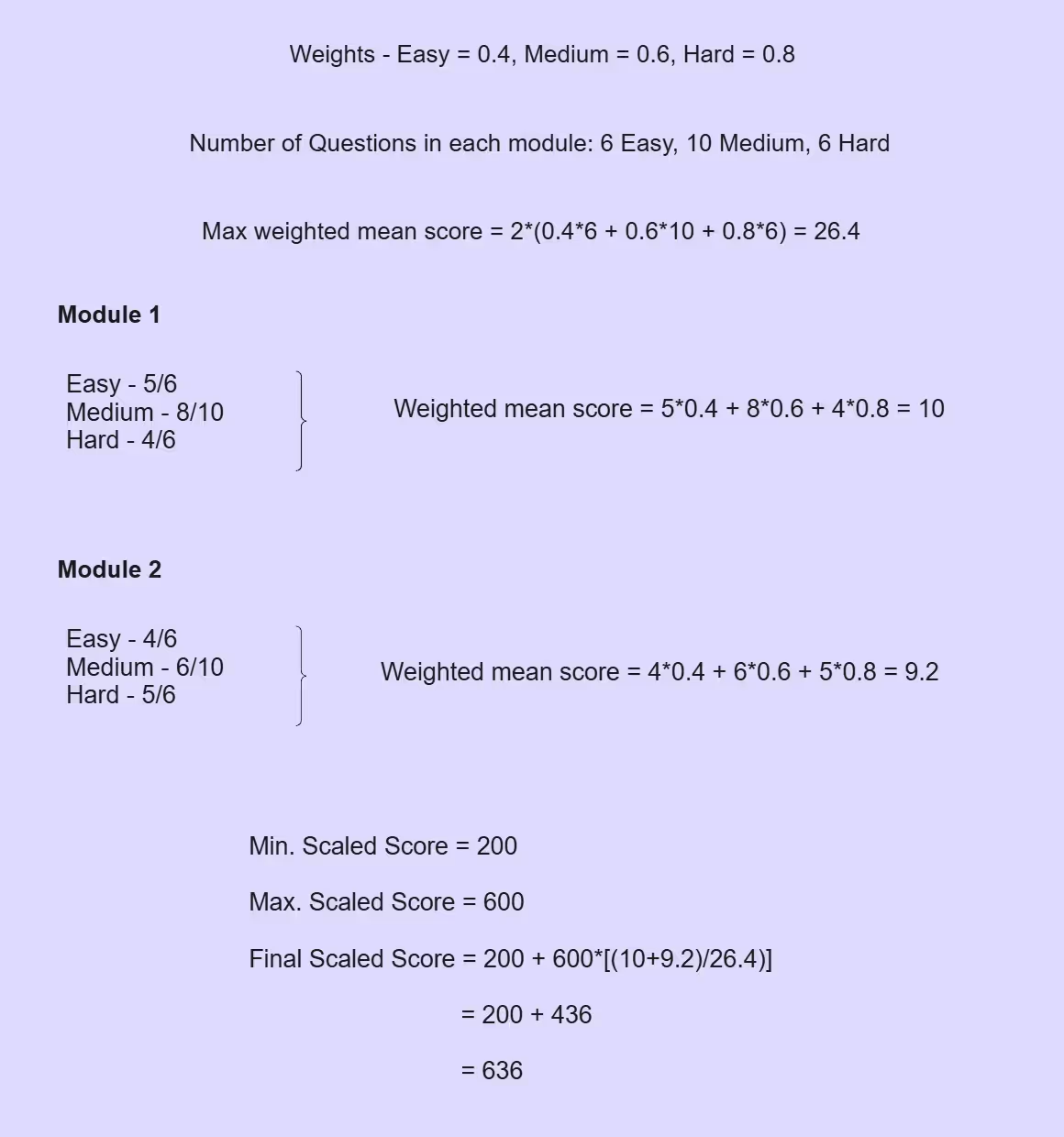
Each question on EdisonOS is tagged with a difficulty level, from very easy to very hard, and each level is assigned a specific weight.
For example:
Very Easy = 0.2
Easy = 0.4
Medium = 0.6
Hard = 0.8
Very hard = 1
These weights are multiplied by the number of correct responses in each difficulty category to calculate the weighted mean score. This method ensures that correctly answering more difficult questions contributes more to a student's final score than answering easier ones.
How does EdisonOS handle the adaptive module?
The minimum scaled score is 200, and the maximum scaled score is 800.
You can find that EdisonOS calculates the weighted mean score separately for each module and adds them up. This total is then scaled using a formula that maps the weighted score to a final scaled score and is bounded by a minimum and a maximum range.
You can find that in the example shown:
- Baseline Module 1 and Adaptive Module 2 are scored separately.
- A maximum score baseline is calculated using the total number of questions and their assigned weights.
The final scaled score is derived using this formula:
Scaled Score = Min Score + [(Total Weighted Score / Max Weighted Score) * (Max Score - Min Score)]
In the example, the final scaled score is 636, which clearly reflects the student's performance across difficulty levels.
Set your own scores

EdisonOS allows tutors to adjust the difficulty weights as per their own scoring logic or institutional standards. For example, if a tutor wants to give more importance to medium-level or hard-level questions, they can increase their weightage in the custom scoring system.
So, this automated precision and manual flexibility to adjust the scores make EdisonOS stand out. This is especially useful for institutions that run proprietary mock exams or want to align scoring with past student performance trends.
Perks of EdisonOS's own scaled score system
Both students and tutors benefit from this customizable scale score system in EdisonOS.
Get better feedback: When students submit the test, EdisonOS automatically converts the raw scores into scaled scores and this gives students and tutors a clear idea of the performance.
Reliable scale score: Since the scaled scoring system is built to reflect the logic used in the actual Digital SAT, students can get a realistic idea of how they are likely to score on the test day.
Custom scoring for more control: Tutors can either use EdisonOS's default system or set their own scaled scoring models. This helps the tutors maintain internal grading styles and map the student's performance against past data.
Get data-driven insights: With scaled scores automatically generated and tracked, educators can now analyze how their students are performing, adjust instruction based on consistent, measurable outcomes, and strategize the mock tests better.
Conclusion
Having a clear understanding of the scoring algorithm used in the digital SAT is essential for optimizing your test performance and aiming for a high score. By recognizing the significance of the second section and employing strategic approaches, such as avoiding blind guessing, one can enhance their chances of obtaining a favorable outcome. Remember that preparing diligently, maintaining accuracy throughout both sections, and leveraging one’s knowledge can showcase their skills effectively on the exam.
P.S: The test trials were only conducted on one test, i.e., Practice Test 1, offered by College Board, to ensure there are no variations in the findings.
Frequently asked questions
There are two modules: Baseline and Adaptive, and each has two sections: Reading & Writing and Math. Adaptive scoring on the Digital SAT means the test changes or adapts based on how the student performs in the first part of each section. The first module in each section consists of a mix of easy, medium, and hard questions. Based on how a student performs in that first module, they are routed to either a harder second module or an easier second module. So, the student's final scaled score depends not only on how many questions the student gets right overall. But the difficulty level at which the student has attended the second module also counts.
The more difficult questions a student attends to, the higher they can score. Even though each question is scored simply as correct or incorrect, not all correct answers can contribute equally in terms of how high your scaled score can go. If a student gets only the easy questions right in the baseline module, they are directed to the easier adaptive module. Even if all the questions are answered correctly, the score potential is limited. Because harder questions carry more weightage to push your score higher.
A big yes! There is a probability that two students might answer the same number of questions correctly and get the same raw score but still end up with different scaled section scores. This happens because the Digital SAT's second module is adaptive. For example, if student A performs well in Module 1, they get a harder Module 2. Correct answers on harder questions give access to higher scoring potential. But if a student B has the same raw score but is directed to the easier Module 2, the overall potential score gets limited.
The second module is given more weightage because it reflects that the student is good enough in Module 1 to be routed to a harder set of questions that carries high scoring potential. Usually, the second module consists of more difficult questions, considering you get the harder version, and the number of correct answers the students manage to get gives more leverage to score high.
Tutors can use scoring insights on EdisonOS to give students personalized test preparation. The platform breaks down the student's performance by section, question type, and difficulty level to find out exactly in what skills they are lacking. With this information, they create personalized study plans and targeted tests for the students to address their weaknesses and track the improvement.

Tutors Edge by EdisonOS
in our newsletter, curated to help tutors stay ahead!
Tutors Edge by EdisonOS
Get Exclusive test insights and updates in our newsletter, curated to help tutors stay ahead!
Recommended Reads
Recommended Podcasts








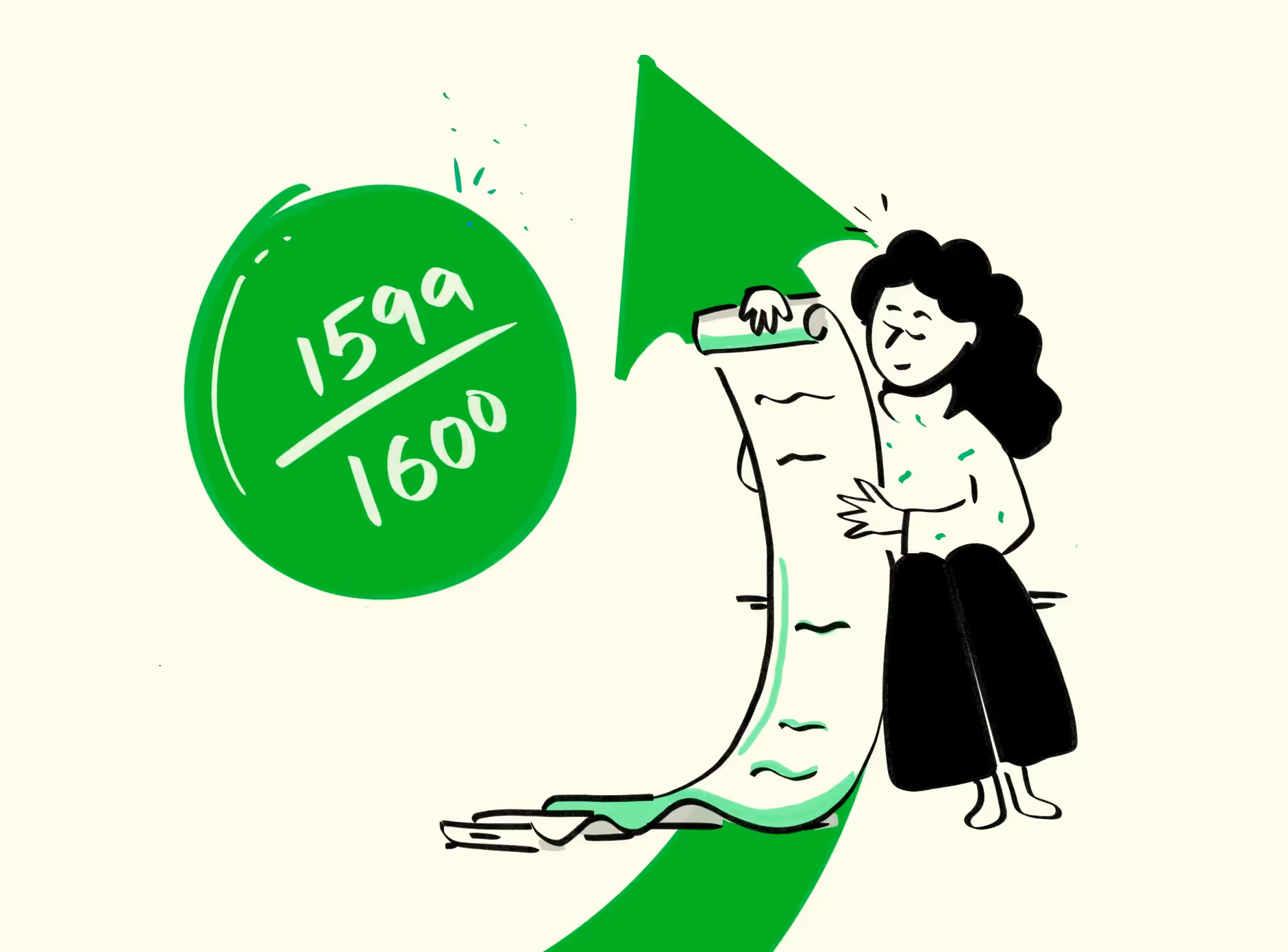



.png)
.webp)
